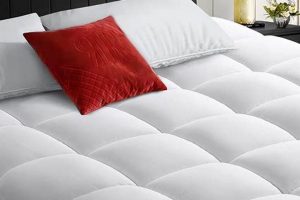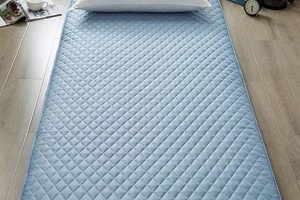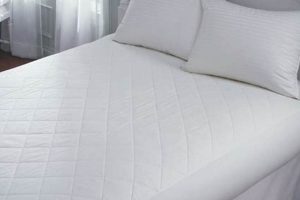These electrically heated bedding accessories provide warmth and comfort, typically used in cold weather conditions. They offer a localized heating solution, regulating temperature for individual users. Both consist of insulated wires embedded within fabric, generating heat when connected to a power source.
Their significance lies in promoting restful sleep and alleviating muscle tension. They can contribute to energy savings by reducing the need to heat an entire room. Historically, the development of these items addressed the need for more efficient and personalized heating options, moving beyond central heating systems.
The subsequent sections will delve into the specific advantages of each type, explore safety considerations, and compare their energy efficiency. Furthermore, factors to consider when purchasing and properly maintaining them will be addressed.
Tips Regarding Electrically Heated Bedding
Optimizing the use of electrically heated bedding requires attention to safety, efficiency, and maintenance. Adherence to the following guidelines will enhance the user experience and prolong the lifespan of the product.
Tip 1: Always inspect the item for signs of wear and tear prior to each use. Check for frayed wires, scorched spots, or damaged controls. Discontinue use immediately if any damage is detected.
Tip 2: Follow the manufacturer’s instructions regarding washing and drying. Many are machine washable, but strict adherence to temperature and drying settings is critical to prevent damage to the internal wiring.
Tip 3: Avoid folding or creasing the item excessively during storage. Sharp creases can damage the internal wiring, leading to malfunctions or potential fire hazards. Roll the item loosely instead.
Tip 4: Use only the control unit that is specifically designed for the product. Substituting with a generic or incompatible control unit can result in overheating or electrical failure.
Tip 5: Do not use the electrically heated bedding with infants, small children, or individuals with reduced sensitivity to heat. These populations are at a higher risk of burns or overheating.
Tip 6: When not in use, disconnect the power cord from the outlet. This practice reduces the risk of electrical hazards and conserves energy.
Tip 7: Consider the energy consumption of the chosen item. Look for models with energy-efficient features or those that allow for precise temperature control to minimize energy waste.
Implementing these tips ensures safe and efficient operation. Regular inspection and proper maintenance are essential for prolonging the life of the item and maximizing its benefits.
The concluding section will summarize the key aspects of choosing the appropriate type and using it responsibly.
1. Temperature Control
Temperature control is a critical feature in electrically heated bedding. It governs the user’s ability to personalize and maintain a comfortable sleeping environment. The sophistication and precision of this control directly influence the overall effectiveness and satisfaction derived from these products.
- Zoned Heating
Zoned heating allows for independent temperature regulation in different sections of the bedding. For example, some models permit independent control of the foot and body areas. This feature caters to individual preferences and physiological differences, such as cooler feet requiring more focused warmth.
- Precise Temperature Settings
The granularity of temperature settings significantly impacts user comfort. Products offering a wide range of settings, with small incremental adjustments, enable users to fine-tune the heat output to their exact preference. Analog controls or digital interfaces can facilitate this level of precision.
- Overheat Protection
While primarily a safety feature, overheat protection indirectly contributes to temperature control. By preventing excessive heat buildup, these systems maintain a consistent and safe temperature range. Thermostats and automatic shut-off mechanisms are common implementations of this safeguard.
- Timer Functionality
Timer functionality allows users to pre-set the duration of heat output. This feature supports energy conservation by automatically turning off the heating element after a specified period. It can also provide timed warmth for falling asleep, gradually reducing the temperature throughout the night.
The capabilities of temperature control systems directly correlate with the overall quality and user experience of electric blankets and electric mattress pads. Advancements in this area continue to enhance comfort, safety, and energy efficiency, making these products increasingly sophisticated and user-friendly.
2. Safety Mechanisms
The integration of robust safety mechanisms is paramount in the design and operation of electrically heated bedding. These mechanisms mitigate potential hazards associated with electrical devices used in close proximity to the body, ensuring user well-being and preventing accidents.
- Overheat Protection Systems
These systems are designed to automatically shut off the heating element if it reaches an unsafe temperature. This is typically achieved through the use of thermostats or thermal fuses that interrupt the electrical circuit. The purpose of overheat protection is to prevent fires and burns, particularly in scenarios where the blanket or pad is folded, bunched, or otherwise obstructed.
- Low Voltage Design
Some modern electric blankets and mattress pads utilize low-voltage systems, often powered by an external transformer. By reducing the voltage running through the heating wires, the risk of electric shock is significantly diminished. This design is particularly beneficial for users who are more susceptible to electrical hazards, such as children or the elderly.
- Automatic Shut-Off Timers
Automatic shut-off timers are employed to limit the duration of operation, reducing the risk of prolonged exposure to heat. These timers can be programmed to turn off the heating element after a pre-set period, typically ranging from a few hours to overnight. This feature also contributes to energy conservation by preventing unnecessary operation.
- Moisture Sensors and Protection
Exposure to moisture can compromise the safety of electrical devices. Some electric blankets and mattress pads incorporate moisture sensors that detect the presence of liquids and automatically shut off the device. Additionally, the wiring and components are often encapsulated in water-resistant materials to further protect against el
ectrical hazards.
The effectiveness of these safety mechanisms depends on diligent adherence to manufacturer guidelines and regular inspection of the product. Damaged cords, exposed wiring, or malfunctioning controls can compromise the integrity of these safeguards, potentially leading to hazardous situations.
3. Material Composition
Material composition significantly influences the functionality, safety, and longevity of electrically heated bedding. The selection of fabrics and insulating materials directly affects heat distribution, user comfort, and resistance to wear. For instance, a blanket composed of tightly woven, fire-retardant synthetic fibers will exhibit different heat retention and safety characteristics compared to one made of loosely knit natural fibers. A primary concern is the potential for overheating, which is mitigated by using materials with appropriate thermal conductivity and resistance to ignition. Moreover, the presence of hypoallergenic materials is crucial for individuals with sensitivities, as prolonged contact with bedding can exacerbate allergic reactions. The construction also dictates washability, an essential factor for hygiene. Improper material choices may lead to uneven heating, premature degradation of heating elements, or increased risk of fire.
Specific examples underscore the importance of careful material selection. Electric blankets utilizing microplush or fleece fabrics offer enhanced softness and comfort, translating to a more pleasant user experience. These materials, however, must be paired with appropriately rated heating wires and insulation to prevent overheating. Mattress pads incorporating memory foam can provide additional cushioning and support, but necessitate flame-retardant treatments to meet safety standards. The type and gauge of the heating wire itself are also critical components of the material composition. Nickel-chromium alloys are commonly used for their high resistance and ability to generate heat efficiently. The insulation surrounding these wires must be durable and heat-resistant to prevent short circuits or electrical leakage.
In summary, material composition is not merely an aesthetic consideration but a fundamental aspect of electrically heated bedding design. The choice of materials directly impacts heat distribution, safety, comfort, and durability. Understanding these connections is vital for both manufacturers and consumers to ensure the safe and effective operation of these products. Challenges remain in balancing cost, comfort, and safety, prompting ongoing research into innovative materials and construction techniques.
4. Energy Efficiency
The operational cost of electrically heated bedding is directly tied to its energy efficiency. These items function by converting electrical energy into heat, and the efficiency of this conversion determines the amount of electricity consumed to achieve a desired temperature. A less efficient unit will draw more power to produce the same level of warmth as a more efficient counterpart, resulting in higher electricity bills. Consequently, energy efficiency should be a primary consideration when selecting an electric blanket or mattress pad.
Several factors contribute to the overall energy efficiency. The quality of the insulation surrounding the heating wires plays a critical role, as it minimizes heat loss and ensures that the generated heat is directed towards the user. Products with thicker or more effective insulation require less energy to maintain a consistent temperature. Programmable timers also enhance energy efficiency by allowing users to set specific operating periods, preventing the unit from running unnecessarily throughout the night. Some models incorporate low-voltage designs, which inherently consume less power than standard voltage systems. Moreover, the responsiveness of the thermostat influences efficiency; a thermostat that accurately and quickly adjusts the heat output based on the ambient temperature minimizes energy waste.
In summary, energy efficiency is an essential attribute of electrically heated bedding, impacting both the user’s operating costs and environmental footprint. Choosing models with robust insulation, programmable timers, and efficient thermostats can significantly reduce energy consumption. A careful evaluation of energy efficiency metrics, often available in product specifications, allows consumers to make informed decisions that balance comfort with responsible energy usage.
5. Size & Fit
The dimensions of electrically heated bedding are crucial for safety, functionality, and user comfort. Improper sizing can lead to ineffective heating, potential hazards, and reduced lifespan of the product.
- Blanket Coverage and Bed Size
The size of an electric blanket should correspond to the dimensions of the bed it is intended for. An undersized blanket may not provide adequate warmth, while an oversized blanket can bunch up, leading to uneven heating and potential damage to the heating elements. Standard sizes, such as twin, full, queen, and king, ensure compatibility with common mattress dimensions.
- Mattress Pad Overhang and Securement
Electric mattress pads typically feature an elasticized skirt or straps that secure them to the mattress. The ‘fit’ is defined by the depth of the mattress, ensuring the pad remains taut and in place. Insufficient overhang can cause the pad to shift during sleep, potentially damaging the heating elements or creating discomfort. Conversely, excessive overhang can create bunching, impacting heat distribution and potentially posing a safety risk.
- Control Unit Placement and Cord Length
The size and design of the control unit, along with the cord length, directly impact user convenience and safety. The control unit should be easily accessible from the bed, while the cord should be long enough to reach a nearby power outlet without creating a tripping hazard. A short cord can necessitate the use of extension cords, which pose an increased risk of electrical shock or fire.
- Heat Distribution and Body Coverage
The internal heating element grid should provide even heat distribution across the entire surface area of the bedding. Gaps or inconsistencies in the heating element placement can result in cold spots, reducing comfort and potentially leading to localized overheating in other areas. The size of the heated area should be proportionate to the bed size and intended number of users.
Proper sizing and secure fit are essential for maximizing the benefits of electrically heated bedding. Selecting the correct dimensions ensures effective heating, user safety, and extended product lifespan. Prior to purchase, precise measurements of the mattress and careful consideration of cord length and control unit placement are recommended.
6. Washability
The washability of electrically heated bedding, including electric blankets
and mattress pads, is a critical factor affecting hygiene, longevity, and user satisfaction. The capacity to effectively clean these items addresses the accumulation of body oils, dust mites, and other allergens. Infrequent or improper cleaning can lead to the degradation of fabric, promote bacterial growth, and diminish the overall performance of the heating elements. Consequently, design and manufacturing considerations must prioritize ease of cleaning without compromising electrical safety or functionality.
The ability to safely launder these items is contingent upon specific design features. Many modern electric blankets and mattress pads are machine washable, provided that the manufacturer’s instructions are strictly followed. These instructions typically involve disconnecting the control unit, ensuring that all wiring is properly sealed and protected, and adhering to recommended water temperatures and drying cycles. In some instances, hand washing may be recommended for older or more delicate models to prevent damage to the internal wiring. The frequency of washing should be balanced against the potential for wear and tear, with most manufacturers recommending cleaning once or twice per year or as needed to address specific stains or soiling.
The advent of washable electric blankets and mattress pads represents a significant advancement in product design, addressing consumer demand for hygienic and easily maintained bedding. However, the process requires careful adherence to guidelines to avoid electrical hazards and ensure the continued functionality of the heating elements. Failure to follow these instructions can result in damage to the product, voiding of warranties, and potentially creating unsafe operating conditions. Thus, washability is a vital attribute, but responsible handling remains paramount.
7. Lifespan
The longevity of electrically heated bedding is a key consideration for consumers, representing a balance between initial investment and long-term value. Understanding the factors that influence product lifespan is crucial for making informed purchasing decisions and ensuring safe, reliable operation.
- Material Quality and Construction
The materials used in manufacturing, particularly the heating wires and insulation, directly affect lifespan. Higher-quality components are more resistant to wear and tear, prolonging the product’s operational life. For example, heating wires made from durable alloys and encased in robust insulation are less prone to damage from repeated flexing and temperature fluctuations. Conversely, substandard materials may degrade rapidly, leading to premature failure of the heating element.
- Usage Frequency and Intensity
The frequency and intensity of use significantly impact the lifespan of electrically heated bedding. Products used nightly at high heat settings will experience greater stress than those used sparingly at lower temperatures. Over time, this cumulative stress can cause wear and tear on the internal components, reducing the product’s overall longevity. Prudent usage patterns, such as using the timer function and avoiding excessively high temperatures, can help extend lifespan.
- Maintenance and Storage Practices
Proper maintenance and storage are essential for maximizing the lifespan. Regularly inspecting the product for signs of damage, such as frayed cords or exposed wires, and promptly addressing any issues can prevent further degradation. Correct washing and drying procedures, as outlined by the manufacturer, are also critical. Improper storage, such as tightly folding or compressing the bedding, can damage the heating elements and shorten lifespan.
- Technological Obsolescence and Component Availability
Even if the physical components of electrically heated bedding remain functional, technological obsolescence can render the product unusable. Control units may fail, and replacement parts may become unavailable, effectively ending the product’s lifespan. Furthermore, advancements in safety standards or energy efficiency may make older models obsolete, prompting consumers to replace them with newer, more technologically advanced alternatives.
In conclusion, the lifespan is governed by a combination of material quality, usage patterns, maintenance practices, and technological factors. While some factors are within the user’s control, others are inherent to the design and manufacturing of the product. Consumers should consider these factors when selecting electrically heated bedding to ensure they receive a safe, reliable, and long-lasting product.
Frequently Asked Questions
This section addresses common inquiries regarding the safe and effective use of electrically heated bedding, encompassing electric blankets and electric mattress pads.
Question 1: Is it safe to use electrically heated bedding with pets?
While some pets may tolerate electrically heated bedding, potential risks exist. Pets can damage the wiring through chewing or scratching, leading to electrical hazards. Overheating is also a concern, particularly for animals unable to regulate their body temperature effectively. Supervised use is advisable, and regular inspection for damage is critical.
Question 2: Can electrically heated bedding cause electromagnetic field (EMF) exposure?
Electrically heated bedding does emit EMFs during operation. However, the levels are generally considered low and within safety guidelines. Individuals with concerns about EMF exposure may consider limiting usage duration or selecting models with EMF-shielding technology, although the efficacy of such shielding varies.
Question 3: How should one properly store electrically heated bedding during the off-season?
Proper storage is essential for preserving the integrity of the heating elements. The item should be disconnected from the power source and allowed to cool completely. It should then be loosely rolled or folded, avoiding sharp creases that can damage the wiring. Storage in a dry, climate-controlled environment is recommended to prevent moisture damage or degradation of the materials.
Question 4: What is the expected lifespan of electrically heated bedding?
The lifespan varies depending on usage frequency, maintenance, and material quality. Generally, expect a lifespan of three to ten years. Regular inspection for wear and tear, proper storage, and adherence to cleaning instructions can extend the lifespan. Warranties offer some indication of the manufacturer’s confidence in product durability.
Question 5: Can electrically heated bedding be used with memory foam mattresses?
Compatibility with memory foam mattresses depends on the specific product. Some memory foam mattresses are sensitive to heat and may degrade or lose their properties if subjected to prolonged exposure to high temperatures. Consult the mattress manufacturer’s guidelines before using any electrically heated bedding. Lower heat settings are generally recommended.
Question 6: What are the key differences between an electric blanket and an electric mattress pad?
An electric blanket is typically placed on top of the bed linens, providing a layer of warmth over the user. An electric mattress pad, conversely, is placed directly on the mattress, beneath the bed linens. Mattress pads tend to provide more consistent and even heat distribution due to their proximity to the sleeping surface. The choice between the two depends on indivi
dual preferences and desired heat distribution.
In summary, responsible operation and consistent maintenance contribute to the longevity and safety of these products. Prioritize adherence to manufacturer guidelines.
The concluding section summarizes the information about electric blankets or electric mattress pads.
Conclusion
The preceding discussion has examined electrically heated bedding options, encompassing both electric blankets and electric mattress pads. Key considerations include safety mechanisms, material composition, energy efficiency, size and fit, washability, and lifespan. These elements influence the overall effectiveness and suitability of either type for individual needs.
Careful evaluation of these factors is essential to ensure safe operation and long-term satisfaction. Continued advancements in technology and materials promise further improvements in the performance, safety, and energy efficiency of electric blanket or electric mattress pad, enhancing their role in promoting comfort and well-being.


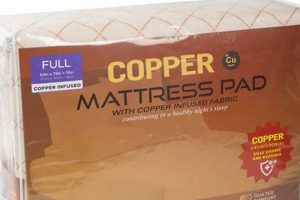
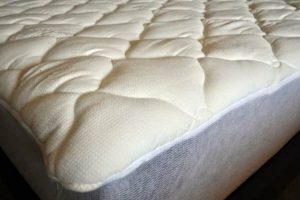
![Top Rated: Best Mattress Pad for Back Pain Relief [Guide] Organic & Natural Mattress Buyer’s Guide: Non-Toxic Sleep Solutions Top Rated: Best Mattress Pad for Back Pain Relief [Guide] | Organic & Natural Mattress Buyer’s Guide: Non-Toxic Sleep Solutions](https://mattressworldpa.com/wp-content/uploads/2025/07/th-4688-300x200.jpg)
